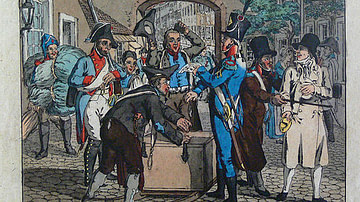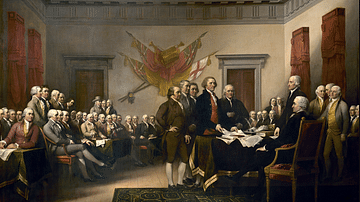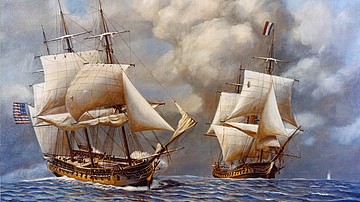
The Chesapeake-Leopard affair was an incident that took place off the coast of Norfolk, Virginia, on 22 June 1807 when the British warship HMS Leopard fired on and boarded an American frigate USS Chesapeake while searching for deserters from the Royal Navy. The incident was one of the events that led to the War of 1812.
Background
In 1807, as the United States was still struggling to find its footing as an independent nation, the Napoleonic Wars were raging in Europe. Napoleon Bonaparte, having crowned himself Emperor of the French three years before, found himself opposed by a series of ever-shifting coalitions of European nations bankrolled by Great Britain. On land, Napoleon's armies had proved dominant; with such great victories as the Battle of Austerlitz (2 December 1805) and the Battle of Friedland (14 June 1807), he had conquered Central Europe and was now exerting influence throughout most of the continent. Britain, meanwhile, had smashed French naval power at the Battle of Trafalgar (21 October 1805) and was afterwards the undisputed master of the waves. This dichotomy left the neutral United States in a precarious position: to deal with one empire meant to upset the other. President Thomas Jefferson, nervously keeping tabs on the developments in Europe, voiced the concerns of many of his countrymen when he wrote: "What an awful spectacle does the world exhibit in this instant, one man bestriding the continent of Europe like a Colossus, and another roaming unbridled on the ocean" (Wood, 622).
But even as the war created anxiety in America, so, too, did it open the door of opportunity. American merchants were quick to capitalize on the gap in international trade caused by the fighting; with France and Spain no longer able to send merchant ships to their colonies in the West Indies, these colonies reluctantly opened their ports to American ships instead. The Americans would then re-export these Caribbean goods to European markets, making a fortune in the process. In 1807, the combined value of American imports and exports reached $243 million, turning the United States into the largest neutral carrier of goods in the world. When Britain complained that the United States' middleman trade strategy violated their so-called Rule of 1756 – which prevented nations from trading in times of war with ports that had been closed to them in times of peace – the Americans circumvented the rule by importing the Caribbean goods to the United States before re-exporting them to Europe, technically turning them into neutral cargo in the process.
American shipping would become threatened, however, as the Franco-British rivalry reached its stalemate. Unable to directly attack the British Isles due to the power of the Royal Navy, Napoleon decided to instead force Britain's submission by paralyzing its economy. In November 1806, he issued the Berlin Decree, the first block in his Continental System, in which he issued a continent-wide embargo on British trade. Any ship carrying British goods was liable for seizure, including those belonging to neutral countries. Britain retaliated with several orders-in-council, which placed a blockade on all ports that complied with Napoleon's embargo, stipulating that all nations who wished to trade at these ports had to first stop in England to pay transit duties. This, of course, left the American merchants in a difficult situation, as they could no longer trade at any European port without running afoul of either the French or the British. Before long, the warring empires were each seizing neutral American ships; between 1803 and 1812, France seized 558 American vessels, while the British captured 917.
Impressment
The seizures caused outrage in the United States not only because they hindered a lucrative trade but also because they were viewed as attacks on American sovereignty; they felt if the European powers could treat the United States with such disrespect and suffer no consequences, then the United States was no better than a colony, and the American Revolution would have been for nothing. But Britain was deemed to be by far the worst culprit because it was not only seizing American ships and cargo, but American sailors as well. Since the opening of hostilities, Britain had been forced to triple the size of its navy, considered the most important deterrent to a French invasion of the British Isles. Bigger fleets required more manpower, but many British subjects were reluctant to enlist because of the infamously poor conditions aboard British warships. As the English writer Samuel Johnson had once quipped, "No man will be a sailor who has contrivance enough to get himself into jail; for being in a ship is being in jail, with the chance of being drowned" (quoted in Berton, 31).

Consequently, many British sailors had been impressed into service and were looking for the first opportunity to jump ship. They would find it aboard American merchant vessels. Not only could British deserters easily hide amongst a crew of Americans – who, after all, looked the same as them and spoke their language – but the American merchant ships offered four times the pay as the Royal Navy and boasted much better living conditions. Before long, US Secretary of the Treasury Albert Gallatin would estimate that 9,000 of the 24,000 sailors on American ships were British subjects. The British Admiralty was aware of this issue and, in response, authorized its officers to board American merchant ships, and impress any sailor who lacked the necessary documents proving they were US citizens. But since the American sailors did indeed look and act like their British cousins, many of them were inevitably snatched up in the process; in the period leading up to the War of 1812, Britain would later admit to having impressed 3,000 American sailors into service in the Royal Navy, with the United States estimating the number was at least twice as high. It was blatant kidnapping, in the words of John Quincy Adams, who went on to state that "No nation can be independent which suffers her citizens to be stolen from her at the discretion of the naval or military officers of another" (quoted in Berton, 30).
The Incident
Such was the international situation when, in February 1807, the British frigate HMS Melampus was anchored off Hampton Roads in southeastern Virginia. Amongst the ship's crew were three American sailors who had been impressed into British service. Two of them – William Ware, a Native American, and Daniel Martin, a Black man – had been sailors aboard the USS Chesapeake until they had been impressed by the British 15 months before in the Bay of Biscay. The third was John Strachan, a White man from Maryland, who had been impressed off Cape Finisterre two years before. The three of them had long been looking for a chance to escape their forced service, a chance they would find one night as the ship's officers were engaged in festivities below deck. Every boat had been hoisted in except the captain's boat, offering up a perfect opportunity. The three Americans leaped into the boat and were off. The British sailors fired muskets at them but could not ready a boat in time to pursue, and the Americans safely reached the shore.
The Americans made their way to port and, looking for work, signed onboard the USS Chesapeake, which Ware and Martin had both previously served on. Also amongst the Chesapeake's crew was a London-born man named Jenkin Ratford, an actual British deserter. Ratford had been brazen enough to taunt British officers and sailors as he strolled around the streets of Norfolk, Virginia, leading the Royal Navy to mark him out for recapture. As the Chesapeake put to sea, British Vice Admiral George Berkeley was determined to seize the four deserters onboard; since the Chesapeake had recently taken on many other new recruits, Berkeley was convinced that there were other British deserters onboard as well, serving under assumed names. At the time, Berkeley was in command of several British warships that were blockading two French ships in Chesapeake Bay. Opting to remain behind with the rest of his fleet to maintain the blockade, Berkeley dispatched his flagship – the fourth-rate HMS Leopard – in pursuit of the Chesapeake.
On 22 June 1807, the Leopard caught up with the Chesapeake off the coast of Norfolk. The British captain, Salusbury Pryce Humphreys, hailed the American ship and sent his lieutenant over with a search warrant. The American naval officer, Commodore James Barron, was determined to protect the men under his command and feigned ignorance, telling the lieutenant that he did not have any deserters onboard. After several minutes of discussion, the British lieutenant returned to the Leopard, after which Captain Humphreys repeated his demands through a hailing trumpet, once again telling Barron to hand over the four deserters. Barron once again refused, prompting the Leopard to fire a warning shot across the Chesapeake's bow. Still, the Americans gave no reply.
The Leopard then unleashed broadsides with its port guns, sending 21 cannonballs smashing into the Chesepeake's starboard side, with additional balls felling its mainmast and punching holes through its sails. The Chesapeake, whose guns had been stowed away, was only able to fire one shot in reply before it was all over. After a ten-minute bombardment, the Chesapeake struck its colors; three American sailors had been killed, and 18, including Barron, had been wounded. Humphreys refused to acknowledge the surrender and sent men onboard to round up the crew and search for the deserters. It turned out that a large portion of the Cheseapeake's crew were British subjects, but Humphreys only took Ratford and the three men who had deserted from HMS Melampus. Then, leaving the Chesapeake smoldering off the coast of Virginia, Leopard continued on to Halifax to court-martial the four deserters. Jenkin Ratford was hanged on 31 August 1807, while the other three were sentenced to 500 lashes each, although these sentences were ultimately commuted.
American Response: The Embargo Act
The Chesapeake-Leopard affair went beyond the usual indignation caused by British seizures and impressments; now a Royal Navy warship had gone so far as to fire on an American vessel and, in the process, kill and maim American sailors. It was a blatant affront to American sovereignty and honor. Soon, Americans from all political affiliations were united in their clamor for war, with President Jefferson summarizing their sentiment: "This country has never been in such a state of excitement since the Battle of Lexington" (quoted in Wood, 647). Jefferson immediately prohibited all British ships from entering American ports, unless they were there for diplomatic purposes or were in distress. He declared all British ships to be "enemies" and privately began making plans for war, conversing with his admirals about strengthening harbor defenses and giving orders to state governors to prepare 100,000 militiamen for a possible invasion of Canada.

The British government, realizing the hornet's nest it had kicked up, was the first to back down. It apologized for the incident and recalled both Berkeley and Humphreys from service in American waters. Additionally, Britain offered to pay for the repairs to the USS Chesapeake as well as to return the three captured sailors – Ratford having already been hanged – as a show of goodwill. Jefferson, who had also been hoping to avoid a war, nevertheless believed that the apology did not go far enough. He would not be appeased until Britain promised to stop impressing sailors from American ships. When it became clear that no such concession was forthcoming, Jefferson announced a new policy on 18 December 1807, that called for a general trade embargo against all foreign nations. Congress accepted this proposal and passed the Embargo Act of 1807.
The Embargo Act was intended to be a show of strength without taking the drastic step of declaring war. However, it ended up backfiring, as its negative effects on the American economy outweighed any economic pressure it may have put on Britain or France. British merchants simply adapted, turning to South American markets for the goods they needed, while for Napoleon, the Embargo Act was in line with his Continental System that he had wanted the Americans to adhere to in the first place. At the same time, the embargo hurt regions like New England that depended on trade while, along the New York-Canadian border, illicit trade continued despite the decree. Before long, it was clear the Embargo Act had failed, and it was finally repealed, effective on the day of James Madison's presidential inauguration on 4 March 1809.
Conclusion
While it did not directly cause a war, the Chesapeake-Leopard affair marked a steep decline in relations between the United States and Great Britain. With Britain's refusal to stop impressing American sailors, and the failure of the United States to assert its strength with the Embargo Act, it was only a matter of time before the two nations would clash in the War of 1812.








